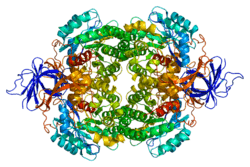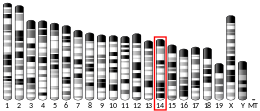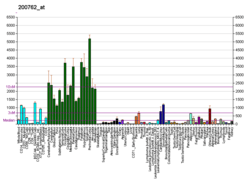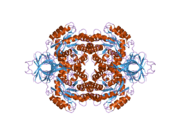DPYSL2
Dihydropyrimidinase-related protein 2 is an enzyme that in humans is encoded by the DPYSL2 gene.[5][6]
Interactions
DPYSL2 has been shown to interact with CRMP1,[7] Adaptor-related protein complex 2, alpha 1[8] and NUMB.[8]
gollark: You said `or even a cc emulator in cc`, please stop being hypocritical.
gollark: jrengen: look at discord, you can see that bit of code the potatOS sandbox has for, OH LOOK, running the BIOS inside a filesystem sandboxing.
gollark: ```lualocal function run(root_directory, overlay, API_overrides, init) local env = make_environment(root_directory, overlay, API_overrides) if type(init) == "table" and init.URL then init = fetch(init.URL) end init = init or fetch "https://pastebin.com/raw/wKdMTPwQ" env.init_code = init local out, err = load(init, "@init.lua", "t", env) if not out then error(err) end env.hypercalls.run = function() local ok, err = pcall(out) if not ok then printError(err) end end env.hypercalls.run()end```
gollark: You can't modify machine.llua.
gollark: Wow that works awfully.
References
- GRCh38: Ensembl release 89: ENSG00000092964 - Ensembl, May 2017
- GRCm38: Ensembl release 89: ENSMUSG00000022048 - Ensembl, May 2017
- "Human PubMed Reference:". National Center for Biotechnology Information, U.S. National Library of Medicine.
- "Mouse PubMed Reference:". National Center for Biotechnology Information, U.S. National Library of Medicine.
- Hamajima N, Matsuda K, Sakata S, Tamaki N, Sasaki M, Nonaka M (Jan 1997). "A novel gene family defined by human dihydropyrimidinase and three related proteins with differential tissue distribution". Gene. 180 (1–2): 157–63. doi:10.1016/S0378-1119(96)00445-3. PMID 8973361.
- "Entrez Gene: DPYSL2 dihydropyrimidinase-like 2".
- Leung, Thomas; Ng Yvonne; Cheong Albert; Ng Chong Han; Tan Ivan; Hall Christine; Lim Louis (Dec 2002). "p80 ROKalpha binding protein is a novel splice variant of CRMP-1 which associates with CRMP-2 and modulates RhoA-induced neuronal morphology". FEBS Lett. Netherlands. 532 (3): 445–9. doi:10.1016/S0014-5793(02)03736-5. ISSN 0014-5793. PMID 12482610.
- Nishimura, Takashi; Fukata Yuko; Kato Katsuhiro; Yamaguchi Tomoya; Matsuura Yoshiharu; Kamiguchi Hiroyuki; Kaibuchi Kozo (Sep 2003). "CRMP-2 regulates polarized Numb-mediated endocytosis for axon growth". Nat. Cell Biol. England. 5 (9): 819–26. doi:10.1038/ncb1039. ISSN 1465-7392. PMID 12942088.
Further reading
- Dawson SJ, White LA (1992). "Treatment of Haemophilus aphrophilus endocarditis with ciprofloxacin". J. Infect. 24 (3): 317–20. doi:10.1016/S0163-4453(05)80037-4. PMID 1602151.
- Goshima Y, Nakamura F, Strittmatter P, Strittmatter SM (1995). "Collapsin-induced growth cone collapse mediated by an intracellular protein related to UNC-33". Nature. 376 (6540): 509–14. Bibcode:1995Natur.376..509G. doi:10.1038/376509a0. PMID 7637782.
- Maruyama K, Sugano S (1994). "Oligo-capping: a simple method to replace the cap structure of eukaryotic mRNAs with oligoribonucleotides". Gene. 138 (1–2): 171–4. doi:10.1016/0378-1119(94)90802-8. PMID 8125298.
- Roberts RG, Freeman TC, Kendall E, et al. (1996). "Characterization of DRP2, a novel human dystrophin homologue". Nat. Genet. 13 (2): 223–6. doi:10.1038/ng0696-223. PMID 8640231.
- Suzuki Y, Yoshitomo-Nakagawa K, Maruyama K, et al. (1997). "Construction and characterization of a full length-enriched and a 5'-end-enriched cDNA library". Gene. 200 (1–2): 149–56. doi:10.1016/S0378-1119(97)00411-3. PMID 9373149.
- Kitamura K, Takayama M, Hamajima N, et al. (2000). "Characterization of the human dihydropyrimidinase-related protein 2 (DRP-2) gene". DNA Res. 6 (5): 291–7. doi:10.1093/dnares/6.5.291. PMID 10574455.
- Gu Y, Hamajima N, Ihara Y (2000). "Neurofibrillary tangle-associated collapsin response mediator protein-2 (CRMP-2) is highly phosphorylated on Thr-509, Ser-518, and Ser-522". Biochemistry. 39 (15): 4267–75. doi:10.1021/bi992323h. PMID 10757975.
- Gu Y, Ihara Y (2000). "Evidence that collapsin response mediator protein-2 is involved in the dynamics of microtubules". J. Biol. Chem. 275 (24): 17917–20. doi:10.1074/jbc.C000179200. PMID 10770920.
- Arimura N, Inagaki N, Chihara K, et al. (2000). "Phosphorylation of collapsin response mediator protein-2 by Rho-kinase. Evidence for two separate signaling pathways for growth cone collapse". J. Biol. Chem. 275 (31): 23973–80. doi:10.1074/jbc.M001032200. PMID 10818093.
- Fukada M, Watakabe I, Yuasa-Kawada J, et al. (2001). "Molecular characterization of CRMP5, a novel member of the collapsin response mediator protein family". J. Biol. Chem. 275 (48): 37957–65. doi:10.1074/jbc.M003277200. PMID 10956643.
- Santolini E, Puri C, Salcini AE, et al. (2001). "Numb Is an Endocytic Protein". J. Cell Biol. 151 (6): 1345–52. doi:10.1083/jcb.151.6.1345. PMC 2190585. PMID 11121447.
- Lee S, Kim JH, Lee CS, et al. (2002). "Collapsin response mediator protein-2 inhibits neuronal phospholipase D(2) activity by direct interaction". J. Biol. Chem. 277 (8): 6542–9. doi:10.1074/jbc.M108047200. PMID 11741937.
- Weitzdoerfer R, Fountoulakis M, Lubec G (2002). "Aberrant expression of dihydropyrimidinase related proteins-2,-3 and -4 in fetal Down syndrome brain". J. Neural Transm. Suppl. (61): 95–107. doi:10.1007/978-3-7091-6262-0_8. ISBN 978-3-211-83704-7. PMID 11771764.
- Fukata Y, Itoh TJ, Kimura T, et al. (2002). "CRMP-2 binds to tubulin heterodimers to promote microtubule assembly". Nat. Cell Biol. 4 (8): 583–91. doi:10.1038/ncb825. PMID 12134159.
- Strausberg RL, Feingold EA, Grouse LH, et al. (2003). "Generation and initial analysis of more than 15,000 full-length human and mouse cDNA sequences". Proc. Natl. Acad. Sci. U.S.A. 99 (26): 16899–903. Bibcode:2002PNAS...9916899M. doi:10.1073/pnas.242603899. PMC 139241. PMID 12477932.
- Leung T, Ng Y, Cheong A, et al. (2003). "p80 ROKalpha binding protein is a novel splice variant of CRMP-1 which associates with CRMP-2 and modulates RhoA-induced neuronal morphology". FEBS Lett. 532 (3): 445–9. doi:10.1016/S0014-5793(02)03736-5. PMID 12482610.
- Nishimura T, Fukata Y, Kato K, et al. (2003). "CRMP-2 regulates polarized Numb-mediated endocytosis for axon growth". Nat. Cell Biol. 5 (9): 819–26. doi:10.1038/ncb1039. PMID 12942088.
- Nakata K, Ujike H, Tanaka Y, et al. (2003). "No association between the dihydropyrimidinase-related protein 2 (DRP-2) gene and bipolar disorder in humans". Neurosci. Lett. 349 (3): 171–4. doi:10.1016/S0304-3940(03)00824-3. PMID 12951196.
- Ota T, Suzuki Y, Nishikawa T, et al. (2004). "Complete sequencing and characterization of 21,243 full-length human cDNAs". Nat. Genet. 36 (1): 40–5. doi:10.1038/ng1285. PMID 14702039.
This article is issued from Wikipedia. The text is licensed under Creative Commons - Attribution - Sharealike. Additional terms may apply for the media files.






